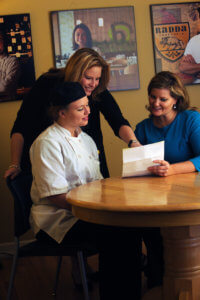You’ve crossed the stage and received your degree or diploma. Congratulations! You’re ready to move on to the next step in your career.
It’s also time to start repaying your student loans. And if you’ve never had this type of loan before, you may be unclear about what happens next. After all, you probably took the loans out months—if not years—ago. Do you even remember their original amounts?
Follow along as we demystify the student loan repayment process. By the end, you’ll know how to pay back your loans—and what to do if you run into trouble.
What Kind of Loans Do I Have?
Federal, private, subsidized, unsubsidized… what kind of loans do you have?
Every student’s financial aid package is unique, and can often be a combination of personal funding, grants, and loans. According to the financial aid department at Auguste Escoffier School of Culinary Arts, many Escoffier students fund their education with a Pell Grant and at least one federal loan.
A Pell Grant is a financial award granted based on need, and it typically does not have to be repaid. Pell Grant eligibility is assessed by filling out the FAFSA. The maximum federal Pell Grant award for the 2024-2025 school year is $7,395.
To supplement a Pell Grant, many students take out federal student loans, which do have to be repaid. Undergraduates can borrow a maximum of $10,500 per year through federal Direct Loans. Up to $4,500 of that amount may be classified as a subsidized loan. For students whose status qualifies as “Dependent,” the max is $6,500. Check the eligibility requirements for your specific situation.
A subsidized loan doesn’t start accruing interest until six months after you either graduate or drop below half-time student status. A half-time student is enrolled in half (or fewer) of the school’s expected full-time course load. Students may drop to half-time if they’re having trouble completing the full course load. But be careful, because this can trigger repayment obligations.
If there is still a funding gap, you may have private loans as well. These loans are provided by banks, credit unions, or lending companies like Fannie Mae, Freddie Mac, or SoFi. They often have higher interest rates than federal loans, which is why it’s best to start with lower interest federal options.
Exit Counseling Forms
In the weeks leading up to graduation, every student who has received a federal student loan must, by law, complete exit counseling paperwork. This is to make sure that you understand your loans and know how to repay them. Exit counseling can be completed through the StudentAid website.
Student Loan Repayment Strategies
If you have multiple loans, how should you approach them? Start by making the minimum monthly payment on each loan. Set up automatic transfers for each loan on the same day each month. That way, you won’t risk late payments.
If you can contribute anything extra to your loans each month and pay them down more quickly, you can save yourself interest charges over the years of repayment. Two popular approaches for paying student loan debt faster are the ”snowball method” and the ”avalanche method.” Both approaches require you to make minimum payments on all but one of your loans. Then you’ll send extra funds to that one loan until it is paid off. But where these strategies differ is in which loan you pay down first.
The Snowball Method
This repayment strategy focuses on repaying your loan with the smallest balance first. Then, you’ll move on to the loan with the next smallest balance, and so on. It’s called the snowball method because as you pay off each loan, you build momentum, like a snowball rolling down a mountain.
This method is popular because it provides quicker wins than the next method, and can keep you motivated.
The Avalanche Method
This repayment strategy has you focusing on the loan with the highest interest rate first in order to avoid paying extra interest fees, especially if the loan has a particularly high balance. This method will usually see you paying the lowest total amount over the life of your loans, since you knock out the most “expensive” debt first.
Which Is Best?
There are strong arguments on both sides, and neither is right or wrong. If you’re an accomplishment-oriented person, the snowball method may be your best bet. If you’re more interested in minimizing your interest payments over the life of the loan, the avalanche approach might be better.

What Is Loan Consolidation, and When Can It Help?
As we’ve discussed, you may have multiple federal loans funding your education. When you consolidate your federal loans, you combine some or all of these loans into one with a single payment and a single interest rate. Consolidation can also extend the repayment schedule, which reduces your monthly payments but can increase the amount you pay over the life of the loan.
You may also choose a private lender to consolidate your student loans. You could essentially take out a new private loan to pay off your existing private and/or federal debt with its various repayment amounts and interest rates. Private consolidation can make the repayment process easier, and it may help to lower your monthly payments.
But it’s not always the right choice. Federal student loans often have lower interest rates than private loans. So consolidating your federal debt into a private loan can actually increase your payments due to the higher interest rate. You can also lose certain protections if you consolidate federal loans into a private loan, like forbearance or deferment (which we’ll discuss shortly.)
It’s all about the details. Look at your current and proposed interest rates and repayment schedule to see if consolidation is a smart choice. A debt consolidation calculator can help you with this.

What Should I Do If I’m Having Trouble Repaying My Loans?
If you miss a payment on your loan, it is considered delinquent. A delinquent loan account can ding your credit score. But as long as you pay the bill soon, it will return to good standing, and the credit impact can be minor.
If your delinquent account stays unpaid, it will go into default. Federal loans are considered to be in default after 270 days of nonpayment. Private student loans usually only allow 120 days of nonpayment before they reach default status.
Once your loan is in default, the loan provider will take steps to recover their money, which could mean garnishing your wages or tax refunds. A default can also impact your credit score significantly, which can make it harder to buy a car or a home, or qualify for credit cards. Private lenders may even take you to court.
It’s always scary when you can’t meet your financial obligations. But the worst thing you can do if you can’t make your payments is to ignore the problem. If you contact your federal or private lender, they will often work with you to get you back on track.

One option is loan deferment, which pauses your payments. Deferment could be a single month, or it could last for up to three years. During the pause, no interest will accrue on your account. This will let you get your finances in better shape before the loan payments resume.
Loan forbearance is another option. This also lets you pause payments, but the loan will continue to accrue interest (unless it’s a subsidized federal loan).
Both federal and private loans providers may be willing to help you through deferment, forbearance, or reduced monthly payments. Default is not only bad for you, but it’s expensive for the loan provider. So it’s usually in everyone’s best interest to come to a solution. If you’re in a tough spot, don’t be afraid to speak up and ask for help.
There are a wide variety of other repayment plans offered by the U.S. Department of Education, including the Pay As You Earn (PAYE) Repayment Plan, the Income-Driven Repayment (IDR) Plan, the Income-Contingent Repayment (ICR) Plan, and the Saving on a Valuable Education (SAVE) Plan. Monthly payment amounts, income tax rates, and recalculation periods will vary loan by loan, so be sure to do thorough research on the Department website to find the right fit.
With a Plan, Loan Repayment Doesn’t Have to Be Complicated
Repaying your student loans, just like getting through culinary school, simply requires a plan. With the Escoffier team of financial aid advisors on your side, you can finish school with a clear understanding of your loan obligations and a plan for how to repay them.
Talk to a financial aid advisor about how you can fund your education and get started on the path to a career you’ll love!
To learn more about how to fund your culinary school education, try these articles next:
- Top Merit-Based Culinary Scholarships
- How Much Does Culinary School Cost and How Can You Pay For It?
- How to Get Into Culinary School
This article was originally published on October 22, 2021 and has since been updated.

